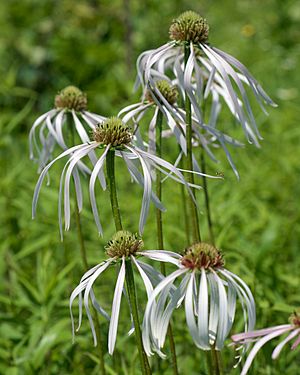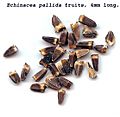Pale purple coneflower facts for kids
Quick facts for kids Pale purple coneflower |
|
|---|---|
 |
|
| Scientific classification | |
| Genus: |
Echinacea
|
| Species: |
pallida
|
| Synonyms | |
|
|
Echinacea pallida, also known as the pale purple coneflower, is a type of herbaceous plant. This means it has soft stems, not woody ones like trees. It's a perennial, so it lives for more than two years. This plant belongs to the sunflower family, called Asteraceae.
People sometimes grow pale purple coneflowers in their gardens. It is also used for herbal remedies. This plant naturally grows in the central part of the United States.
Contents
What the Pale Purple Coneflower Looks Like
The pale purple coneflower is similar to another plant called E. angustifolia. However, Echinacea pallida plants often grow taller. They usually reach about 1.5 to 2.5 feet (45 to 75 cm) in height. Some can even grow to 3 feet (90 cm) or more!
In the wild, these plants usually have one main stem that doesn't branch out. But if you grow them in a garden, they might form bigger clumps with many stems. They have deep taproots, which are like long, thick main roots. These roots are wider in the middle and get thinner at the ends.
The stems of the plant can be green. Sometimes, they are a mix of purple and green. The leaves are long and narrow, shaped like a spear. They have three clear veins running through them.
The flowers look a bit like daisies. The petals, which are called ray florets, are thin and long. They often droop downwards. These petals can be from 1 to 3 inches (2.5 to 7.5 cm) long. The whole flower head is usually between 0.75 to 3 inches (2 to 7.5 cm) wide. The petals are typically a pale rose-purple color. Sometimes, they can even be almost white. The flowers have white pollen. Pale purple coneflowers bloom from May through July. After the flowers fade, they produce small, tan or two-colored fruits. These fruits have angled edges.
Where Pale Purple Coneflowers Grow
You can find the pale purple coneflower in several parts of the United States. It grows in the Mississippi Valley area. It's also found in the southeastern Great Plains. Another region where it grows is south of Lake Michigan.
Most of these plants are found from southern Wisconsin and Iowa down to Louisiana and eastern Texas. There have also been reports of them in the Southeastern United States. You might also find them in New England, New York, Michigan, and Ontario (in Canada). However, many of these might be plants that were introduced by people, not growing there naturally.
Habitat and Conservation
The pale purple coneflower grows in different natural areas. In the states of Tennessee and Wisconsin, this plant is listed as threatened. This means its numbers are decreasing. The main reasons for this are that its natural homes are being lost. Also, too many roots are collected for herbal medicine.
The pale purple coneflower is important for some insects. It is a host plant for the larvae (young caterpillars) of the silvery checkerspot butterfly. This means the caterpillars eat the plant's leaves.
Images for kids
See also
 In Spanish: Equinácea pálida para niños
In Spanish: Equinácea pálida para niños





